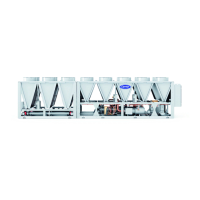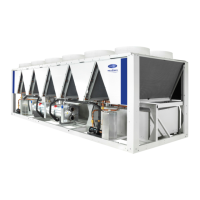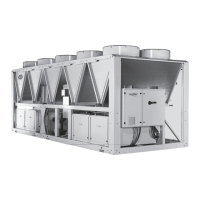41
Typical configuration of the Alarm Routing variable is
11010000. This Alarm Routing status will transmit alarms to
ComfortVIEW
™
software, TeLink, BACLink, and DataLINK.
This option cannot be configured with the Touch Pilot dis-
play. To change the alarm control routing through the Network
Service Tool, navigate to point ALRM_CNT in table
ALARMDEF.
ALARM EQUIPMENT PRIORITY — The ComfortVIEW
software uses the equipment priority value when sorting alarms
by level. The purpose of the equipment priority value is to de-
termine the order in which to sort alarms that have the same
level. A priority of 0 is the highest and would appear first when
sorted. A priority of 7 would appear last when sorted. For ex-
ample, if two chillers send out identical alarms, the chiller with
the higher priority would be listed first. The default is 4. This
variable can only be changed when using the ComfortVIEW
software, or Network Service Tool. This variable cannot be
changed with the Touch Pilot display. To configure this option
with the Network Service Tool, navigate to point EQ-_TYP in
table ALARMDEF.
COMMUNICATION FAILURE RETRY TIME — This vari-
able specifies the amount of time that will be allowed to elapse
between alarm retries. Retries occur when an alarm is not ac-
knowledged by a network alarm acknowledger, which may use
either ComfortVIEW software or TeLink. If acknowledgment is
not received, the alarm will be re-transmitted after the number
of minutes specified in this decision. This variable can only be
changed when using the ComfortVIEW software, or Network
Service Tool. This variable cannot be changed with the Touch
Pilot display. To configure this option with the Network Service
Tool, navigate to point RET-Y_TM in table ALARMDEF.
RE-ALARM TIME — This variable specifies the amount of
time that will be allowed to elapse between re-alarms. A re-
alarm occurs when the conditions that caused the initial alarm
continue to persist for the number of minutes specified in this
decision. Re-alarming will continue to occur at the specified in-
terval until the condition causing the alarm is corrected. This
variable can only be changed when using the ComfortVIEW
software, or Network Service Tool. This variable cannot be
changed with the Touch Pilot display. To configure this option
with the Network Service Tool, navigate to point RE-_LARM
in table ALARMDEF.
ALARM SYSTEM NAME — This variable specifies the
system element name that will appear in the alarms generated
by the unit control. The name can be up to 8 alphanumeric
characters in length. This variable can only be changed when
using the ComfortVIEW™ software or Network Service Tool.
This variable cannot be changed with the Touch Pilot display.
To configure this option with the Network Service Tool, navi-
gate to point ALRM_NAM in table ALARMDEF.
Daylight Savings Time Configuration — The
30XV chiller with Greenspeed
®
intelligence control con-
tains software which can automatically correct for daylight
saving time. This software is accessible from the Touch Pi-
lot™ display, ComfortVIEW software, or Network Service
Tool.
To enable this feature, Daylight Saving Select must be set to
1. The start of daylight saving must be configured by setting
the Month, Day of Week, and Week of Month. The end for
Daylight Saving must also be configured. To configure this op-
tion with the Touch Pilot display, see Table 28.
Table 28 — Daylight Saving Time Configuration
Capacity Control Overrides — The following ca-
pacity control overrides (Main Menu Maintenance Menu
Capacity Control Override Capacity A, B) will modify the
normal operation routine. If any of the override conditions list-
ed below is satisfied, the override will determine the capacity
change instead of the normal control. Overrides are listed by
priority order and are often linked to unit operating modes. See
Table 29 for a list of capacity control overrides. See the Operat-
ing Modes section on page 48 for more information regarding
operating modes.
Override #2: Low Suction Pressure
— This override is acti-
vated when the EXV is not in DSH mode and the suction satu-
ration temperature (SST) goes below 13.25 F (–10.4 C) for wa-
ter or below (13.25 – (34 – Brine Freeze Setpoint)) for units
configured with brine. The controller at this point starts to un-
load the unit until the SST exceeds 34 F (1.1 C).
Override #6: EWT < Control Point
—This override stops the
compressors without alarms.
Override #7: Ramp Loading
— No capacity increase will be
made if the unit is configured for ramp loading and the rate of
change of the leaving water is greater than Ramp Loading
Rate.
Override #9: Demand Limit
— This override mode is active
when a command to limit the capacity is received and the ca-
pacity meets or exceeds the demand limit value. If the current
unit capacity is greater than the active capacity limit value, the
unit unloads per unloading scheme. The current capacity will
stop increasing when it reaches the capacity limit value minus
3%.
Override #10: Flow Switch is Open
— This override prohib-
its compressor operation until the Evaporator flow switch is
closed.
Override #11: Customer Interlock is Closed
— This override
prohibits compressor operation until the customer interlock is
opened.
Override #12: Flow Available Delay
— This override pro-
hibits chiller operation until flow has started.
DISPLAY NAME PATH VALUE
Activate
Main Menu
Configuration Menu
Broadcast Menu
Brocasts
1 or 2
Default = 2
Daylight
Savings Select
Enable
Default = Dsble
Entering
Month
Enter Starting
Month for
Daylight Saving
Day of Week
(1=Monday)
Enter the Day of
the Week Daylight
Saving Starts
Week of Month
Enter Week of
the Month Daylight
Saving Starts
Leaving
Month
Enter Ending
Month for
Daylight Saving
Day of Week
(1=Monday)
Enter the Day of
the Week Daylight
Saving ends
Week of Month
Enter Week of
the Month Daylight
Saving ends

